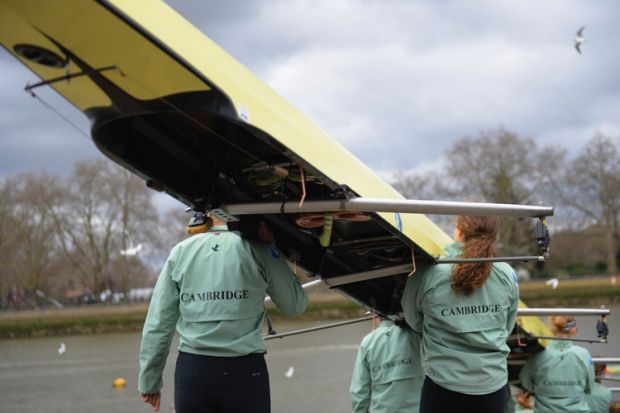Source: Getty
In January, Mary Curnock Cook, the chief executive of Ucas, sounded a warning that young men were becoming a “disadvantaged group” when it came to university applications.
“There remains a stubborn gap between male and female applicants which, on current trends, could eclipse the gap between rich and poor within a decade,” she said.
By the main January deadline for those applying for courses starting in 2014-15, 333,700 women had applied to university through Ucas, compared with just 246,300 men. In England, women aged 18 were a third more likely to apply to university than men, the figures revealed.
The problem has entered the national consciousness, and Ms Curnock Cook’s comments made newspaper headlines, although she has made similar arguments before. “University gender gap widens,” exclaimed The Daily Telegraph. “Boys left behind,” warned the Daily Mail.
The Ucas figures are certainly troubling, but they do not tell the whole story. When the data are scrutinised in depth, the results are surprising – and arguably even more dispiriting for men.
While the Ucas statistics show that in England 18-year-old women were a third more likely to apply, this does not represent an immediate worsening of the situation.
“This proportional difference has remained steady between 2012 and 2014,” says the document UK application rates by country, region, sex, age and background (2014 cycle, January deadline).
Over the past decade the gap in application rates has widened, but only slightly. In 2004, 23 per cent of 18-year-old men from England applied to university compared with just under 30 per cent of women. So a decade ago, women were already significantly ahead.
In Scotland, however, the gap is even bigger. Women are an extraordinary 49 per cent more likely to apply than men, up from 44 per cent in 2013. “This increase has been driven by an increase in the application rate from women, while the application rate for men has remained unchanged,” the Ucas document says.
And if one looks beyond full-time, young undergraduate students, British men are also trailing far behind women.
Of part-time UK undergraduates, men made up just 38 per cent of the total in 2012-13, according to the most recent data from the Higher Education Statistics Agency. Men also comprised a mere 41.2 per cent of all UK postgraduates in 2012-13.
An overseas offset
It might therefore come as a surprise to learn that in recent years campuses have actually become less, not more, female – at least in terms of the student body.
The proportion of female students in UK universities hit a peak in 2005-06. Ever since, it has been coming down, despite the widening gap in application rates recorded by Ucas.
In 1996-97, women were only slightly better represented at university: 52.5 per cent of students were female.
This proportion shot up over the next decade, hitting 57.3 per cent in 2005-06. Since then, however, it has gradually shrunk, to 56.2 per cent in 2012-13, according to Hesa.
How is this possible when young British women are leaving their male counterparts in the dust in terms of Ucas applications?
One explanation is that an influx of male students from outside the UK has counterbalanced the rise of females from the UK.
In 2012-13 female students are in the majority across almost every level of study – taught postgraduate degrees, other postgraduate qualifications, as well as non-first-time undergraduate degrees – but only when just UK students are included in the count (they were outnumbered by men on higher research degrees, however).
Examine the overseas cohort, and the picture is dramatically different. Men make up the majority of first-degree students from outside the European Union. Of higher research degree students from outside the EU, men make up almost 58 per cent.
The plateau in the percentage of female students at UK universities, then, “is likely to reflect an increasing share of international students dominated by boys”, according to Jürgen Enders, professor of higher education at the University of Southampton.
Other Hesa data make clear the impact of students from outside the EU on the gender balance in UK universities. In 2012-13, 56.2 per cent of students were female. But among the non-UK cohort, this falls to 50.5 per cent, and among non-EU students, women are actually in a minority (48.8 per cent).
More detailed statistics show that this difference likely has a regional or cultural dimension. A total of 26,380 students in UK institutions came from the Middle East, but only a third of those were women. Of the 34,160 African students in the UK, 41.4 per cent were women.
Students from Asia – the continent that is by far the largest source of overseas students – were 50.7 per cent female.
This relative gender balance may surprise some because China, which sends the most students abroad of any country by far, has many more young men than women.
For every woman aged 15 to 24 in China, there are 1.11 men, according to the CIA World Factbook for 2013.
But even the predominance of males among international students appears to be coming to an end. Look back to 1996-97, and women made up 45.3 per cent of non-UK students. Now they are a majority.
“Boys getting outperformed in education by girls reflects an international trend, also to be found in the UK,” Professor Enders said.
Boys, you’ve been outplayed
Are there any crumbs of comfort for men in these figures, or are they simply being comprehensively beaten by women in the classroom?
The rise in female participation is happening during “a period of a declining graduate premium – at least in the UK”, according to Professor Enders. “This raises questions about the benefits of higher education for women, and [about] boys eventually finding other routes to attractive jobs and salaries.”
Indeed, it has been suggested that men in the UK are more likely to get a job straight out of school, through an apprenticeship, for example.
Women are much more likely than men to work part-time, and so are perhaps better able to study part-time, Professor Enders added.
But Bahram Bekhradnia, president of the Higher Education Policy Institute, thinks that the gap at part-time level “is just part of the overall picture that women participate in higher education much more than men”.
“Women get better degrees, they are more likely to get jobs and they are less likely to drop out. Women just do better than men,” he said.
Hepi examined these issues in 2009 in a report, Male and Female Participation and Progression in Higher Education, which found that differences could be explained simply by the fact that girls do better than boys at school.
But it did also acknowledge that economic returns to higher education for women were greater, and that the incorporation of female-dominated subjects such as nursing had also contributed to the gap, so providing at least a couple of excuses for men.
Regardless of why the gap exists, it appears even more pronounced at part-time and postgraduate levels than the headline Ucas statistics would suggest.
This arguably makes the fact that just one in five professors in the UK is female all the more jarring – universities have become places where the students are largely female, but the academics mostly male.
Register to continue
Why register?
- Registration is free and only takes a moment
- Once registered, you can read 3 articles a month
- Sign up for our newsletter
Subscribe
Or subscribe for unlimited access to:
- Unlimited access to news, views, insights & reviews
- Digital editions
- Digital access to THE’s university and college rankings analysis
Already registered or a current subscriber? Login





